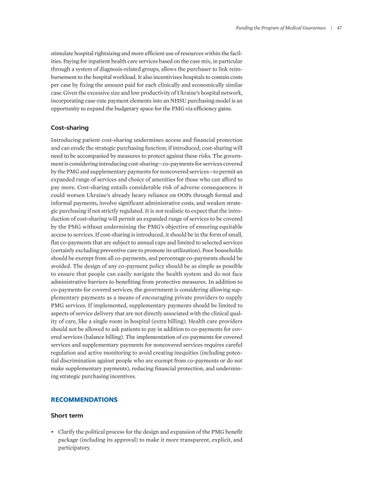Funding the Program of Medical Guarantees
stimulate hospital rightsizing and more efficient use of resources within the facilities. Paying for inpatient health care services based on the case mix, in particular through a system of diagnosis-related groups, allows the purchaser to link reimbursement to the hospital workload. It also incentivizes hospitals to contain costs per case by fixing the amount paid for each clinically and economically similar case. Given the excessive size and low productivity of Ukraine’s hospital network, incorporating case-rate payment elements into an NHSU purchasing model is an opportunity to expand the budgetary space for the PMG via efficiency gains.
Cost-sharing Introducing patient cost-sharing undermines access and financial protection and can erode the strategic purchasing function; if introduced, cost-sharing will need to be accompanied by measures to protect against these risks. The government is considering introducing cost-sharing—co-payments for services covered by the PMG and supplementary payments for noncovered services—to permit an expanded range of services and choice of amenities for those who can afford to pay more. Cost-sharing entails considerable risk of adverse consequences: it could worsen Ukraine’s already heavy reliance on OOPs through formal and informal payments, involve significant administrative costs, and weaken strategic purchasing if not strictly regulated. It is not realistic to expect that the introduction of cost-sharing will permit an expanded range of services to be covered by the PMG without undermining the PMG’s objective of ensuring equitable access to services. If cost-sharing is introduced, it should be in the form of small, flat co-payments that are subject to annual caps and limited to selected services (certainly excluding preventive care to promote its utilization). Poor households should be exempt from all co-payments, and percentage co-payments should be avoided. The design of any co-payment policy should be as simple as possible to ensure that people can easily navigate the health system and do not face administrative barriers to benefiting from protective measures. In addition to co-payments for covered services, the government is considering allowing supplementary payments as a means of encouraging private providers to supply PMG services. If implemented, supplementary payments should be limited to aspects of service delivery that are not directly associated with the clinical quality of care, like a single room in hospital (extra billing). Health care providers should not be allowed to ask patients to pay in addition to co-payments for covered services (balance billing). The implementation of co-payments for covered services and supplementary payments for noncovered services requires careful regulation and active monitoring to avoid creating inequities (including potential discrimination against people who are exempt from co-payments or do not make supplementary payments), reducing financial protection, and undermining strategic purchasing incentives.
RECOMMENDATIONS Short term • Clarify the political process for the design and expansion of the PMG benefit package (including its approval) to make it more transparent, explicit, and participatory.
|
47

